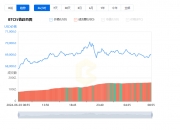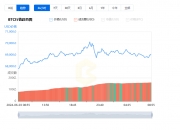互联网迄今有两个阶段:Web 1.0 和 Web 2.0。下一个阶段就是 Web 3.0。
So far, the Internet has two phases xff1a; Web 1.0 and Web 2.0. The next stage is Web 3.0.
Web 1.0 是用户读取互联网,Web 2.0 是用户写入互联网,Web3 是用户生活在互联网。
Web 1.0 is a user who reads the Internet & #xff0c > ; Web 2.0 is a user who writes on the Internet & #xff0c > ; Web3 is a user
互联网三个阶段的特点
Characteristics of the three phases of the Internet
复杂点理解:
Complexity understanding #xff1a;
1.0用户仅获取内容,如新闻门户网站;
1.0 Users only get content xff0c; e.g. news portal xff1b;
2.0用户可创造内容,如抖音B站小红书;
2.0 users can create content & #xff0c; e.g., shivering B station little red book & #xff1b;
3.0数字资产可被确认权属,用户可创造价值。
3.0 Digital assets can be recognized tenure & #xff0c; users can generate value.
简单点理解:
A simple understanding of #xff1a;
1.0信息互联网;2.0身份互联网;3.0契约互联网。
1.0 Information Internet xff1b; 2.0 Identity Internet xff1b; 3.0 Contract Internet.
再简单点理解:
Simpler understanding of #xff1a;
1.0只能读--->2.0可读写--->3.0能确权
1.0 Read only ---> 2.0 readable and written ---> 3.0 authenticated
web3.0到来的三个前提:
#xff1a;
1、博客技术为代表,围绕网民互动及个性体验的互联网应用技术的完善和发展。
1. Blog technology is representative of & #xff0c; refinement and development of Internet applications around Internet people's interactions and personal experiences.
2、虚拟货币的普及和普遍,以及虚拟货币的兑换成为现实。
The spread and prevalence of virtual currency xff0c; and the conversion of virtual currency became a reality.
3、大家对网络财富的认同,以及网络财务安全的解决方案。
3. Recognition of network wealth & #xff0c; and solutions for network financial security.
Web3.0时代将更加凸显网络的三大功能:信息共享、网络传播和电子商务,这三大功能恰恰涉及人类生活三大基本面。
The Web3.0 era will give greater prominence to the three main functions of the network xff1a; information-sharing, network dissemination and e-commerce ; these three functions relate precisely to the three fundamentals of human life.
web1.0的本质是联合,web2.0的本质就是互动,它让网民更多地参与信息产品的创造、传播和分享,而这个过程是有价值的。web2.0的缺点是没有体现出网民劳动的价值,所以2.0很脆弱,缺乏商业价值,需要跟具体的产业结合起来才会获得巨大的商业价值和商业成功。web3.0是在web2.0的基础上发展起来的能够更好地体现网民的劳动价值,并且能够实现价值均衡分配的一种互联网方式。
The essence of web1.0 is union & #xff0c; the essence of web 2.0 is interaction & #xff0c; it allows the Internet to become more involved in the creation, dissemination and sharing of information products & #xff0c; and the process is valuable. The disadvantage of web 2.0 is that it does not reflect the value of Internet labor & #xff0c; so 2.0 is fragile & #xff0c; lack of commercial value & #xff0c; the combination of specific industries is necessary to achieve great commercial value and success.

Web1.0:一切的开始(1990-2004)
在互联网诞生之初的Web1.0时代,互联网基本上是“只读”模式的,网民可以登录各大门户网站浏览和阅读任何想要看到的新鲜资讯,但只能看不能互动。Web 采用的技术工具包括 IP、HTTP、URI 和 HTML。
At the dawn of the Internet, in the Web 1.0 era & #xff0c; the Internet is basically xff0c of the “read-only” model; the Internet has access to major portals to view and read any new information that you want to see xff0c; but it is not interactive. Web uses technical tools such as IP, HTTP, URI, and HTML.
主要代表就是搜狐,网易,新浪等门户网站。
The main representatives of
Web 1.0 阶段,用户是单纯的内容消费者,内容由网站提供,网站让你看什么,你就看什么,典型例子就是新闻门户网站。
Web 1.0 Phase & #xff0c; user is a simple content consumer & #xff0c; content is available on the website & #xff0c; website what #xff0c shows you; you look at xff0c; typical example is the news portal.

Web2.0:可互动的Web2.0
Web 2.0 阶段,用户是内容的生产者,网站只是一个向用户提供服务的平台,典型的 Web 2.0 平台有维基百科、抖音、微信等等。Web2.0 强调内容的互动,用户不再只是内容接收方,而可以成为内容的提供方,平台的共建者。
Web 2.0 Phase & #xff0c; Users are Content Producers xff0c; Websites are just a service to users xff0c; typical Web 2.0 platforms have Wikipedia, tremors, micro-letters, etc. Web 2.0 emphasizes content interaction xff0c; Users are no longer just content receivers xff0c; they can be content providers xff0c; platform co-builders.
数据成了这些平台最大的财富,也是平台通过广告变现、或者其他形式变现的最主要资源。
data has become the platform's greatest wealth xff0c; it is also the platform's most important resource, either through advertising or in other forms.

Web3.0:未来互联网
Web3.0是对Web2.0的改进,用户不必在不同中心化的平台创建多种身份,而是能打造一个去中心化的通用数字身份体系,通行各个平台。Web3.0被用来描述互联网潜在的下一阶段,一个运行在“区块链”技术之上的“去中心化”的互联网。
Web3.0 is an improvement for Web 2.0 & #xff0c; users do not need to create multiple identities & #xff0c on different centralized platforms; instead, they can create a decentralised universal digital identity system & #xff0c; access platforms. Web3.0 is used to describe the potential next phase of the Internet & #xff0c; an “decentralized” Internet that runs above the block chain technology.
web3.0不仅是一种技术上的革新,而是以统一的通讯协议,通过更加简洁的方式为用户提供更为个性化的互联网信息资讯定制的一种技术整合,将会是互联网发展中由技术创新走向用户理念创新的关键一步。
Web3.0 is not just a technological innovation & #xff0c; it is a unified communication protocol & #xff0c; a technology integration that provides users with more personalized Internet information customization & #xff0c in a more concise way; it will be a key step in the development of the Internet from technological innovation to conceptual innovation for users.
现在的大众共识的Web3.0未来,是基于区块链的去中心化、加密货币以及非同质化代币的发展而演进。目前对于Web3.0还没有统一的定义,但核心特征得到了共识:去中心化、主动性强、多维化,是一个全新的个性化的时代。
The current popular consensus, Web3.0 Future & #xff0c; evolved on the basis of the decentralisation of block chains, encrypt currency, and the development of non-homogenous moneties. There is currently no uniform definition of Web3.0 & #xff0c; but the core features are agreed on xff1a; decentralized, proactive, multi-dimensional xff0c; and it is a completely new era of individualization.
在Web3.0中,用户为满足自身需求进行交互操作,并在交互中利用区块链技术,从而实现价值的创造、分配与流通。这样的整个用户交互、价值流通的过程就形成了Web3.0生态。
In Web3.0 & #xff0c; users interact to meet their needs & #xff0c; and use block chain technology & #xff0c interactively to create, distribute and circulate values. This whole user interaction, value flow, forms the Web3.0 ecology.
主要代表:区块链、元宇宙、DAO、NFT、链游
参考资料:
References xff1a;
1. 什么是 Web3.0?
注册有任何问题请添加 微信:MVIP619 拉你进入群

打开微信扫一扫
添加客服
进入交流群
















发表评论